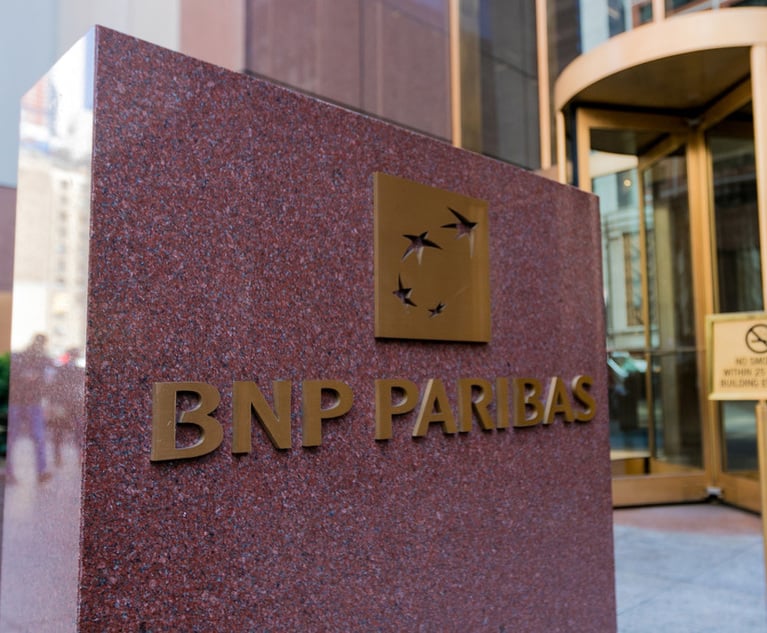Grace Period Expires for Cybersecurity Regulations in NY: What Comes Next?
F. Paul Greene writes: The day has finally arrived for the financial services industry in New York. The new cybersecurity regulations issued by the New York State Department of Financial Services are officially in force, and for the first time, a single state is regulating cybersecurity on a potentially global scale, and it has done so via the regulatory process, not legislative action.
August 25, 2017 at 02:02 PM
16 minute read
The day has finally arrived for the financial services industry in New York. The new cybersecurity regulations issued by the New York State Department of Financial Services are officially in force, after a 180-day grace period that followed the effective date of the regulations, March 1, 2017. These regulations, found at 23 N.Y.C.R.R. Part 500, mark a watershed moment in cybersecurity regulation in the United States. For the first time, a single state is regulating cybersecurity on a potentially global scale, and it has done so via the regulatory process, not legislative action.
These two developments change the landscape of cybersecurity regulation in two very distinct ways. First, by focusing on a global industry regulated within the state, Part 500 magnifies the potential reach of a state regulatory body immensely. Part 500 impacts not only covered financial institutions (defined as Covered Entities), but also third parties located around the world that provide services to these institutions. This is because of the defined Third Party Service Provider Security Policy required by Part 500, under which a Covered Entity must set certain “minimum cybersecurity practices” for every third party service provider doing business with the Covered Entity. It is perhaps because of this potential global reach that DFS attached a two-year phase-in period to the Third Party Service Provider Security Policy requirement.
Second, by choosing the regulatory process to implement Part 500, New York has doubled down on the trend in cybersecurity regulation to infer broad regulatory authority from very general enabling statutes. Case in point, the Federal Trade Commission's extensive efforts to regulate cybersecurity based solely on the general language of the Federal Trade Commission Act. In relation to DFS, the enabling statutes referenced in Part 500 are as silent on cybersecurity as their FTC counterparts. They concern, rather, the department's authority to regulate the financial services industry in New York generally, including its ability to issue fines.
This content has been archived. It is available through our partners, LexisNexis® and Bloomberg Law.
To view this content, please continue to their sites.
Not a Lexis Subscriber?
Subscribe Now
Not a Bloomberg Law Subscriber?
Subscribe Now
NOT FOR REPRINT
© 2025 ALM Global, LLC, All Rights Reserved. Request academic re-use from www.copyright.com. All other uses, submit a request to [email protected]. For more information visit Asset & Logo Licensing.
You Might Like
View All

'Merciless' Filing Deadline Dooms Cuban Americans' Property-Trafficking Suit Against BNP Paribas, SocGen
4 minute read
After 2024's Regulatory Tsunami, Financial Services Firms Hope Storm Clouds Break

Trending Stories
- 1Uber Files RICO Suit Against Plaintiff-Side Firms Alleging Fraudulent Injury Claims
- 2The Law Firm Disrupted: Scrutinizing the Elephant More Than the Mouse
- 3Inherent Diminished Value Damages Unavailable to 3rd-Party Claimants, Court Says
- 4Pa. Defense Firm Sued by Client Over Ex-Eagles Player's $43.5M Med Mal Win
- 5Losses Mount at Morris Manning, but Departing Ex-Chair Stays Bullish About His Old Firm's Future
Who Got The Work
J. Brugh Lower of Gibbons has entered an appearance for industrial equipment supplier Devco Corporation in a pending trademark infringement lawsuit. The suit, accusing the defendant of selling knock-off Graco products, was filed Dec. 18 in New Jersey District Court by Rivkin Radler on behalf of Graco Inc. and Graco Minnesota. The case, assigned to U.S. District Judge Zahid N. Quraishi, is 3:24-cv-11294, Graco Inc. et al v. Devco Corporation.
Who Got The Work
Rebecca Maller-Stein and Kent A. Yalowitz of Arnold & Porter Kaye Scholer have entered their appearances for Hanaco Venture Capital and its executives, Lior Prosor and David Frankel, in a pending securities lawsuit. The action, filed on Dec. 24 in New York Southern District Court by Zell, Aron & Co. on behalf of Goldeneye Advisors, accuses the defendants of negligently and fraudulently managing the plaintiff's $1 million investment. The case, assigned to U.S. District Judge Vernon S. Broderick, is 1:24-cv-09918, Goldeneye Advisors, LLC v. Hanaco Venture Capital, Ltd. et al.
Who Got The Work
Attorneys from A&O Shearman has stepped in as defense counsel for Toronto-Dominion Bank and other defendants in a pending securities class action. The suit, filed Dec. 11 in New York Southern District Court by Bleichmar Fonti & Auld, accuses the defendants of concealing the bank's 'pervasive' deficiencies in regards to its compliance with the Bank Secrecy Act and the quality of its anti-money laundering controls. The case, assigned to U.S. District Judge Arun Subramanian, is 1:24-cv-09445, Gonzalez v. The Toronto-Dominion Bank et al.
Who Got The Work
Crown Castle International, a Pennsylvania company providing shared communications infrastructure, has turned to Luke D. Wolf of Gordon Rees Scully Mansukhani to fend off a pending breach-of-contract lawsuit. The court action, filed Nov. 25 in Michigan Eastern District Court by Hooper Hathaway PC on behalf of The Town Residences LLC, accuses Crown Castle of failing to transfer approximately $30,000 in utility payments from T-Mobile in breach of a roof-top lease and assignment agreement. The case, assigned to U.S. District Judge Susan K. Declercq, is 2:24-cv-13131, The Town Residences LLC v. T-Mobile US, Inc. et al.
Who Got The Work
Wilfred P. Coronato and Daniel M. Schwartz of McCarter & English have stepped in as defense counsel to Electrolux Home Products Inc. in a pending product liability lawsuit. The court action, filed Nov. 26 in New York Eastern District Court by Poulos Lopiccolo PC and Nagel Rice LLP on behalf of David Stern, alleges that the defendant's refrigerators’ drawers and shelving repeatedly break and fall apart within months after purchase. The case, assigned to U.S. District Judge Joan M. Azrack, is 2:24-cv-08204, Stern v. Electrolux Home Products, Inc.
Featured Firms
Law Offices of Gary Martin Hays & Associates, P.C.
(470) 294-1674
Law Offices of Mark E. Salomone
(857) 444-6468
Smith & Hassler
(713) 739-1250






